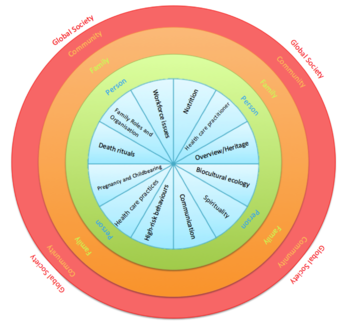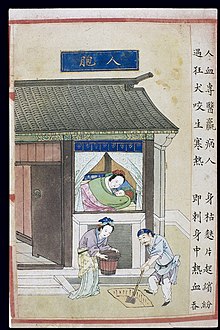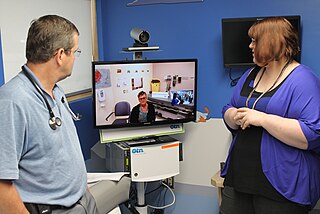
Telenursing refers to the use of information technology in the provision of nursing services whenever physical distance exists between patient and nurse, or between any number of nurses. As a field, it is part of telemedicine, and has many points of contacts with other medical and non-medical applications, such as telediagnosis, teleconsultation, and telemonitoring. The field, however, is still being developed as the information on telenursing isn't comprehensive enough.
Nursing theory is defined as "a creative and conscientious structuring of ideas that project a tentative, purposeful, and systematic view of phenomena". Through systematic inquiry, whether in nursing research or practice, nurses are able to develop knowledge relevant to improving the care of patients. Theory refers to "a coherent group of general propositions used as principles of explanation".
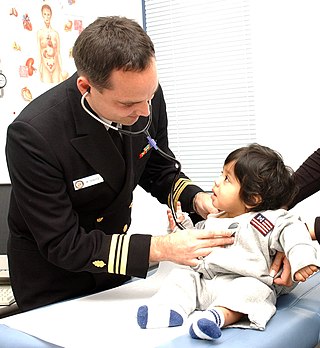
A nurse practitioner (NP) is an advanced practice registered nurse (APRN) and a type of mid-level practitioner. NPs are trained to assess patient needs, order and interpret diagnostic and laboratory tests, diagnose disease, formulate and prescribe medications and treatment plans. NP training covers basic disease prevention, coordination of care, and health promotion. One study found that although reasons for referrals to specialists are similar for both physicians and NPs, the quality of documentation in the referrals may be lower for NPs.
Cultural competence, also known as intercultural competence, is a range of cognitive, affective, behavioural, and linguistic skills that lead to effective and appropriate communication with people of other cultures. Intercultural or cross-cultural education are terms used for the training to achieve cultural competence.
A clinical nurse specialist (CNS) is an advanced practice nurse who can provide advice related to specific conditions or treatment pathways. According to the International Council of Nurses (ICN), an Advanced Practice Nurse is a registered nurse who has acquired the expert knowledge base, complex decision-making skills and clinical competencies for expanded practice, the characteristics of which are shaped by the context and/or country in which s/he is credentialed to practice. Clinical Nurse Specialists are registered nurses who have had graduate level nursing preparation at the master's or doctoral level as a CNS. They are clinical experts in evidence-based nursing practice within a specialty area, treating and managing the health concerns of patients and populations. The CNS specialty may be focused on individuals, populations, settings, type of care, type of problem, or diagnostic systems subspecialty. CNSs practice autonomously and integrate knowledge of disease and medical treatments into the assessment, diagnosis, and treatment of patients' illnesses. These nurses design, implement, and evaluate both patient–specific and population-based programs of care. CNSs provide leadership in the advanced practice of nursing to achieve quality and cost-effective patient outcomes as well as provide leadership of multidisciplinary groups in designing and implementing innovative alternative solutions that address system problems and/or patient care issues. In many jurisdictions, CNSs, as direct care providers, perform comprehensive health assessments, develop differential diagnoses, and may have prescriptive authority. Prescriptive authority allows them to provide pharmacologic and nonpharmacologic treatments and order diagnostic and laboratory tests in addressing and managing specialty health problems of patients and populations. CNSs serve as patient advocates, consultants, and researchers in various settings.
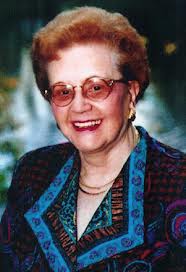
Madeleine Leininger was a nursing theorist, nursing professor and developer of the concept of transcultural nursing. First published in 1961, her contributions to nursing theory involve the discussion of what it is to care.
Transcultural nursing is how professional nursing interacts with the concept of culture. Based in anthropology and nursing, it is supported by nursing theory, research, and practice. It is a specific cognitive specialty in nursing that focuses on global cultures and comparative cultural caring, health, and nursing phenomena. It was established in 1955 as a formal area of inquiry and practice. It is a body of knowledge that assists in providing culturally appropriate nursing care.

Nursing is a profession within the healthcare sector focused on the care of individuals, families, and communities so they may attain, maintain, or recover optimal health and quality of life. Nurses can be differentiated from other healthcare providers by their approach to patient care, training, and scope of practice. Nurses practice in many specialties with differing levels of prescription authority. Nurses comprise the largest component of most healthcare environments; but there is evidence of international shortages of qualified nurses. Nurses collaborate with other healthcare providers such as physicians, nurse practitioners, physical therapists, and psychologists. There is a distinction between nurses and nurse practitioners; in the U.S., the latter are nurses with a graduate degree in advanced practice nursing, and are permitted to prescribe medications unlike the former. They practice independently in a variety of settings in more than half of the United States. Since the postwar period, nurse education has undergone a process of diversification towards advanced and specialized credentials, and many of the traditional regulations and provider roles are changing.
Ambulatory care nursing is the nursing care of patients who receive treatment on an outpatient basis, ie they do not require admission to a hospital for an overnight stay. Ambulatory care includes those clinical, organizational and professional activities engaged in by registered nurses with and for individuals, groups, and populations who seek assistance with improving health and/or seek care for health-related problems. The American Academy of Ambulatory Care Nursing (AAACN) describes ambulatory care nursing as a comprehensive practice which is built on a broad knowledge base of nursing and health sciences, and applies clinical expertise rooted in the nursing process.
Workplace safety in healthcare settings is similar to the workplace safety concerns in most occupations, but there are some unique risk factors, such as chemical exposures, and the distribution of injuries is somewhat different from the average of all occupations. Injuries to workers in healthcare settings usually involve overexertion or falling, such as strained muscles from lifting a patient or slipping on a wet floor. There is a higher than average risk of violence from other people, and a lower than average risk of transportation-related injuries.

Cultural sensitivity, also referred to as cross-cultural sensitivity or cultural awareness, is the knowledge, awareness, and acceptance of other cultures and others' cultural identities. It is related to cultural competence, and is sometimes regarded as the precursor to the achievement of cultural competence, but is a more commonly used term. On the individual level, cultural sensitivity is a state of mind regarding interactions with those different from oneself. Cultural sensitivity enables travelers, workers, and others to successfully navigate interactions with a culture other than their own.
Clinical peer review, also known as medical peer review is the process by which health care professionals, including those in nursing and pharmacy, evaluate each other's clinical performance. A discipline-specific process may be referenced accordingly.
The Clinical Care Classification (CCC) System is a standardized, coded nursing terminology that identifies the discrete elements of nursing practice. The CCC provides a unique framework and coding structure. Used for documenting the plan of care; following the nursing process in all health care settings.

Holistic nursing is a way of treating and taking care of the patient as a whole body, which involves physical, social, environmental, psychological, cultural and religious factors. There are many theories that support the importance of nurses approaching the patient holistically and education on this is there to support the goal of holistic nursing. The important skill to be used in holistic nursing would be communicating skills with patients and other practitioners. This emphasizes that patients being treated would be treated not only in their body but also their mind and spirit.. Holistic nursing is a nursing speciality concerning the integration of one's mind, body, and spirit with his or her environment. This speciality has a theoretical basis in a few grand nursing theories, most notably the science of unitary human beings, as published by Martha E. Rogers in An Introduction to the Theoretical Basis of Nursing, and the mid-range theory Empowered Holistic Nursing Education, as published by Dr. Katie Love. Holistic nursing has gained recognition by the American Nurses Association (ANA) as a nursing specialty with a defined scope of practice and standards. Holistic nursing focuses on the mind, body, and spirit working together as a whole and how spiritual awareness in nursing can help heal illness. Holistic medicine focuses on maintaining optimum well-being and preventing rather than just treating disease.
Genetics nursing is a nursing specialty that focuses on providing genetic healthcare to patients.
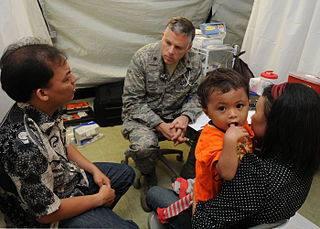
Cultural competence in healthcare refers to the ability for healthcare professionals to demonstrate cultural competence toward patients with diverse values, beliefs, and feelings. This process includes consideration of the individual social, cultural, and psychological needs of patients for effective cross-cultural communication with their health care providers. The goal of cultural competence in health care is to reduce health disparities and to provide optimal care to patients regardless of their race, gender, ethnic background, native languages spoken, and religious or cultural beliefs. Cultural competency training is important in health care fields where human interaction is common, including medicine, nursing, allied health, mental health, social work, pharmacy, oral health, and public health fields.
An acute care nurse practitioner (ACNP) is a registered nurse who has completed an accredited graduate-level educational program that prepares them as a nurse practitioner. This program includes supervised clinical practice to acquire advanced knowledge, skills, and abilities. This education and training qualifies them to independently: (1) perform comprehensive health assessments; (2) order and interpret the full spectrum of diagnostic tests and procedures; (3) use a differential diagnosis to reach a medical diagnosis; and (4) order, provide, and evaluate the outcomes of interventions. The purpose of the ACNP is to provide advanced nursing care across the continuum of health care services to meet the specialized physiologic and psychological needs of patients with acute, critical, and/or complex chronic health conditions. This care is continuous and comprehensive and may be provided in any setting where the patient may be found. The ACNP is a licensed independent practitioner and may autonomously provide care. Whenever appropriate, the ACNP considers formal consultation and/or collaboration involving patients, caregivers, nurses, physicians, and other members of the interprofessional team.
The role of spirituality in health care has received significant research attention due to its benefits for patients and health care professionals. Integrating spirituality in healthcare can enhance healthcare professionals' ability to communicate effectively with patients and families. It can also have a positive impact on the health and well-being of patients due to its potential to enhance patients' ability to cope with illness and achieve better physical and mental health outcomes. As per 2014, more than 70 medical schools in the United States offer courses on spirituality and medicine. The Association of American Medical Colleges has co-sponsored, with the National Institute for Healthcare Research, four conferences, on curricular development in spirituality and medicine since 1997.
Creative Health Care Management (CHCM) is a private U.S. corporation, which provides consultation and training in the health care sector. CHCM is based in Bloomington, Minnesota. Founded in 1982 by Marie Manthey, it was originally called Creative Nursing Management. The name change to CHCM was in recognition of the systemic nature of change.
A nurse scientist is a registered nurse with advanced education and expertise in nursing research. These professionals play a critical role in advancing nursing knowledge, improving patient care, and shaping the future of the nursing profession. Highly educated and specialized, nurse scientists conduct research to generate new knowledge about nursing care, employing a deep understanding of nursing theory, research methodologies, and clinical practice. Nurse scientists are essential contributors to the development of new nursing interventions and practices. Their skills extend beyond academic settings and these advanced nurses work in hospitals, research institutes, and community organizations. Through their efforts, nurse scientists have a profound impact on the quality of healthcare, contributing significantly to the improvement of patient care and the overall advancement of the nursing profession. They possess advanced qualifications, typically holding a Ph.D. in nursing or a related field, demonstrating expertise not only in research principles and methodology but also in-depth content knowledge within a specific clinical area. The primary focus of the role is to provide leadership in the development, coordination and management of clinical research studies; provide mentorship for nurses in research; lead evaluation activities that improve outcomes for patients participating in research studies; contribute to the overall health sciences literature. Nurse scientists have been regarded as knowledge brokers. They participate in nursing research.
